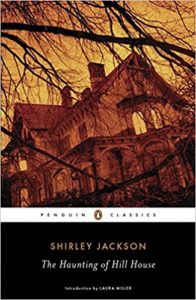Near the end of Jackson’s novel, Luke describes Hill house as being “motherly…Everything so soft. Everything so padded. Great embracing chairs and sofas which turn out to be hard and unwelcome when you sit down, and reject you at once” (154). Yet when the young  future inheritor of Hill House tries to explain the pain he feels as a result of never having a mother to Eleanor and Theodora, they read his confession as the bait of a rakish seducer.
future inheritor of Hill House tries to explain the pain he feels as a result of never having a mother to Eleanor and Theodora, they read his confession as the bait of a rakish seducer.
The seduction motif figures within the novel alongside its larger themes of motherhood, sisterhood, and volatile female friendships. As a member of the landowning class, Luke Sanderson is certainly set up to fulfill the role of the traditional libertine, an aristocratic young man who seeks pleasure and abhors the middle class values of hard work and sentimentality (Combe 338). Unlike the other male characters in the novel (Doctor Montague, Arthur, and Mr. Dudley), Luke’s career is never mentioned or described. The only thing we really know about his possible employment (or unemployment) is that he was able to set aside an indeterminate amount of time in order to take part in Dr. Montague’s experiment at Hill House. However, Luke’s behavior in the house challenges Eleanor’s and Theodore’s reading of him as a rake. He is of constant help to the doctor and even assists in chasing after a phantom dog in the middle of the night.
At the start of the team of four’s first night in the house, Dr. Montague explains that he plans to read Richardson’s Pamela in order to help him fall asleep. Pamela is an epistolary novel written in 1740 which describes the story of a 15 year-old maidservant named Pamela who virtuously resists the seductions of her wealthy land-owning, motherless master, Mr. B. By the end of the novel, her chastity is rewarded and she marries Mr. B. Although Luke is the obvious stand-in for the role of the rake in Jackson’s 1959 gothic novel, I argue that Hill House is the true seducer.
Upon waking up and joining the others for breakfast, our introverted heroine, Eleanor, imagines that she has finally found a family and a sense of belonging. Up until this moment, she has only existed either to serve or hinder others. While her mother was still

Eleanor’s name on the wall of Hill House: A still from The Haunting, Robert Wise’s 1963 film adaptation of The Haunting of Hill House.
alive, Eleanor functioned as her live-in nurse. After her mother’s death, Eleanor moved into her sister’s family’s house, sleeping on a cot in the baby’s room. Eleanor confesses to Theodora that she has never been anywhere where she was wanted and that her greatest fear is to be alone. Hill House seductively offers Eleanor the chance to finally be wanted and to never be lonely. After all, it is her name that appears written on the wall of the long hallway and it is her name again that is received by way of Mrs. Montague’s planchette. Although Eleanor reacts initially with fear and anger, by the end of the novel, her seduction is complete. After being expelled from the house by the rightfully concerned Dr. Montague, she purposefully drives her car into the large tree at the end of the driveway. Moments before hitting the accelerator, she bitterly laughs at the others for foolishly thinking that the House would allow Eleanor to leave. As the car begins to accelerate, she repeats her favorite Shakespearean line one final time: “journeys end in lovers meeting” (181). Unfortunately, the house is no lover; it is a libertine who has successfully elicited Eleanor’s fall from both sanity and life through its false promises of companionship and belonging. The novel ends the same way it begins: “silence lay steadily against the wood and stone of Hill House, and whatever walked there, walked alone” (1, 182). In many early American seduction fictions (ie: The Coquette, Charlotte Temple, Amelia: or The Faithless Briton), the fallen woman dies at the end of the narrative. These deaths are presented as a form of punishment suitable for the young women who fail to maintain their virtue in the presence of libertines. In The Haunting of Hill House, Shirley Jackson continues this tradition by resolving her novel with Eleanor’s suicide, an act which Eleanor considers righteous, but which actually represents her final defeat. Although the reader cannot be sure whether Eleanor’s restless spirit walks along the wooden floors of the Hill House or not, she is certainly damned to an eternity of loneliness.
Works Cited
Combe, Kirk. “Bourgeois Rakes in Wedding Crashers: Feudal to Neo-Liberal Articulations in Modern Comedic Discourse.” Journal of Popular Culture 46.2 (2013): 338–357. EBSCOhost. Web.
Jackson, Shirley. The Haunting of Hill House. Penguin Classics, 2006.